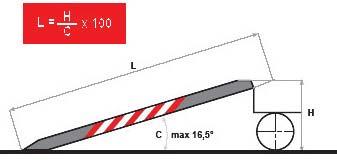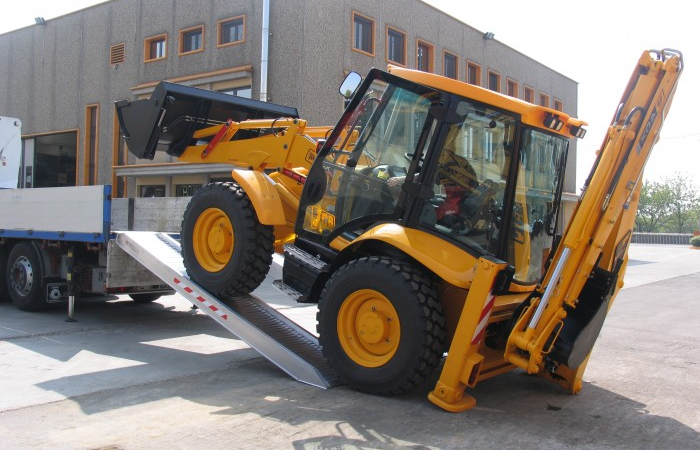Safety standards for use of aluminium ramps

Calculator:
Loading surface height from ground:
Desired ramp length:
What to do with this information:
- Scroll through the catalog.
- Look for your required length in the appropriate (3rd) column.
- Out of those with the required length, pick the product code that best matches your required carrying capacity.
Which one should I pick?
For a quick answer use the calculator provided on the left.
L = Ramp length
H = Loading surface ground height
C = Ramp inclination
Before driving onto the ramp or ramps, please make sure the bottom ends are parallel with the ground, as depicted in the drawing on the left. When deciding what the length of your ramp should be, make sure the ground angle is never over 16.5° - when converting this to a gradient, we get:
C = 30%
Example:
Let's suppose our loading surface is at a height of 1.0 meters from the ground, therefore H = 1000 mm. Keeping in mind that the maximum allowed value for C = 30%, we can determine our ramp length with the formula:

We get:

Our ramp inclination must not exceed 16.5°, but it can alway be less. We can always use a longer ramp, we will just have a more gradual incline. In the catalog, standard model lengths are listed in 500 mm increments. In the case of our example the nearest suitable ramp is: 3500 mm long.
All that's left now is to look at all the models with a 3500 mm length and pick the one with enough carrying capacity for our vehicle wheelbase.
Ramp usage guidelines
- The ramp capacity, as specified by the manufacturer, assumes an even weight distribution according to the wheelbase it was designed to carry.
- The greater the weight concentration (the smaller the wheel/track contact surface area), the lower the ramp carrying capacity.
- When choosing a ramp, we ask that you also consider the minimum wheel/track width listed in the catalog.
- If your unique use case requires shorter ramps that deviate from the standard 16.5° gradient, please contact us for a custom build so the lower contact area matches the loading inclination.
- For loading steel tracked vehicles, ramps should be chosen with a 15% higher carrying capacity.
